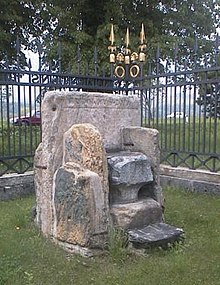Herzogstuhl

The Carinthian Herzogstuhl played an important role in the inauguration of the Dukes of Carinthia .
It was probably built in the second half of the 9th century and is located on the Zollfeld . The duke's chair was first mentioned in a document as sedes Karinthani ducatus on the occasion of Hermann von Spanheim's appointment as duke in 1161. The enthronement of seven sovereigns is documented between 1286 and 1597, and later their appointment was carried out in the Klagenfurt country house .
The Herzogstuhl is designed as a double seat, the western, older seat was reserved for the Count Palatine of Görz , the eastern one for the Duke of Carinthia . The tombstone of a resident of the ancient Roman Virunum was used for the production . In addition to the duke's chair, the prince stone near Karnburg played a prominent role in the ceremony .
The lattice border is designed as a lance grille, which was built in 1834.
literature
- The Herzogstuhl on the Zollfeld near Maria Saal. In: Ostarrîchi - Austria 996-1996. People, myths, milestones. Catalog of the Austrian national exhibition in Neuhofen an der Ybbs and St. Pölten. Edited by Ernst Bruckmüller and Peter Urbanitsch . Catalog of the Lower Austrian State Museum. NF 388. Berger, Horn 1996. XXIV, 736. 4 °. Object no .: 6.1.04, p. 144. ( online , uni-klu.ac.at; ceremony at the Herzogstuhl)
- About the Carinthian Herzogstuhl. In: Carinthia I 157, 1967, pp. 420-468
- The Carinthian Herzogstuhl in the course of history. In: W. Neumann: Building blocks for the history of Carinthia. Commemoration for Wilhelm Neumann on his 70th birthday (= Das Kärntner Landesarchiv 12, Klagenfurt ²1994) pp. 15–23.
- Gotbert Moro: On the time and significance of the Carinthian duke chair. In: Maria Hornung, Dialect and History , Graz 1967, pp. 95–110
- A. Ogris: Fürstenstein and Herzogstuhl - symbols of the Carinthian regional history in the conflict of ethnic and territorial tendencies in Slovenian historiography, journalism and politics. In: Carinthia I 183, 1993, 729ff.
- Josko Šavli : Slovenska znamenja [Slovenian characters]. Založba (Verlag) Humar, Gorica (Görz), Bilje 1994. (The book also contains German-language excerpts and summaries - e.g. Fürstenstein, Herzogstuhl - from the relevant Slovene-language passages.)
Web links
Individual evidence
- ↑ Josef Till: Symbols as identity factors or the prince stone - the great (un) known , ( page no longer available , search in web archives ) Info: The link was automatically marked as defective. Please check the link according to the instructions and then remove this notice. Website of the Catholic Church of Carinthia, Religious Education Institute of the Diocese of Gurk, accessed on December 17, 2007
- ^ Dehio manual. The art monuments of Austria. Carinthia . Anton Schroll, Vienna 2001, ISBN 3-7031-0712-X , p. 1101
Coordinates: 46 ° 41 ′ 27.3 " N , 14 ° 20 ′ 47.3" E
